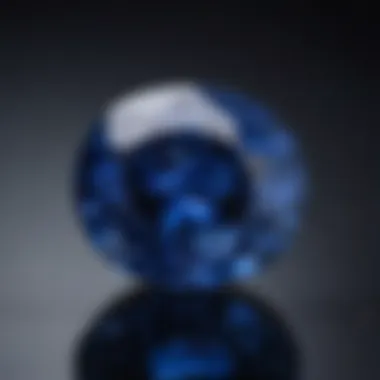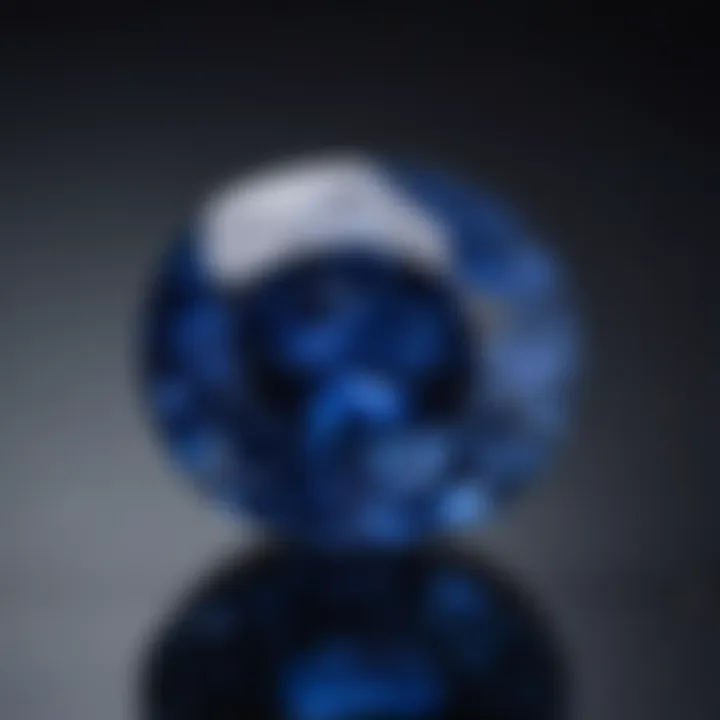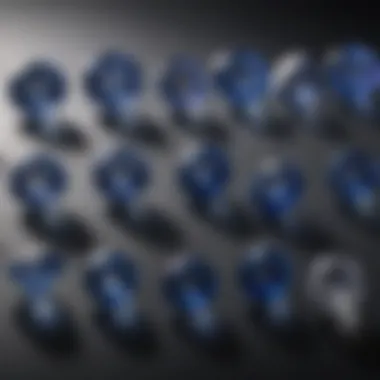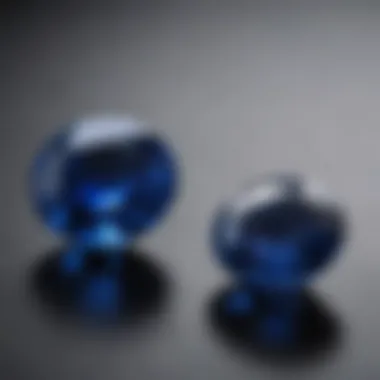Ceylon Sapphire Pricing: Carat Insights and Trends


Intro
Ceylon sapphires, revered for their breathtaking hues, form a significant segment of the gemstone market. Understanding the dynamics of their pricing per carat can provide insights for both new buyers and seasoned collectors. This section introduces the reader to the gemstone landscape, detailing the key aspects influencing sapphire prices.
Gemstone Overview
Definition and Characteristics
Ceylon sapphires are a variety of corundum, distinguished primarily by their blue color. Originating from Sri Lanka, these sapphires are known for their exceptional clarity and brilliance. Their color can range from a light, almost pastel blue to deep, royal tones. Factors such as hue, saturation, and tone play a crucial role in determining their quality and value.
Some prominent characteristics of Ceylon sapphires include:
- Color: The most critical factor. Deep, vivid blue tones are usually the most sought after.
- Clarity: Flawless stones fetch a higher price, though inclusions can add character.
- Cut: A well-cut sapphire enhances its light performance, increasing its appeal.
- Carat Weight: Larger stones naturally command higher prices.
Classification of Gemstones
Gemstones can be broadly classified into precious and semi-precious categories. The term “precious” generally includes diamonds, emeralds, rubies, and sapphires. Ceylon sapphires firmly belong to this grouping due to their rarity and desirability.
Within the category of sapphires, variations exist based on color, origin, and treatment. Ceylon sapphires, specifically, are lauded for their natural vibrancy and are often preferred over other types for investment purposes.
Historical Significance
Ancient Uses and Cultural Importance
Historically, sapphires have been treasured for their beauty and perceived powers. In ancient cultures, they were believed to protect their wearers from envy and harm. Royalty often adorned themselves with these stones, symbolizing wisdom and nobility. Ceylon sapphires, in particular, have a rich history linked to the Sri Lankan culture, where they were mined for centuries.
Myths and Legends Surrounding Gemstones
Many myths surround sapphires, with some cultures considering them a mark of divine favor. For instance, it was said that wearing a sapphire could attract goodness and protect from evil. Such narratives have added layers of intrigue and value to sapphires, particularly those from Ceylon.
"Ceylon sapphires are not merely stones; they are a piece of history, reflecting cultures and beliefs that transcend time."
Foreword to Ceylon Sapphires
Ceylon sapphires hold a venerable place in the world of gemstones. They are renowned for their rich hues and remarkable clarity. This section will discuss the importance of understanding Ceylon sapphires, particularly as it pertains to pricing per carat. Knowing these details aids collectors and buyers in making informed decisions regarding their purchases.
Ceylon sapphires are highly sought after due to their historical significance and the quality that this region has consistently produced. As the demand for these precious stones increases, so does the complexity of their pricing. Buyers need to comprehend what influences these prices, including market trends and grading criteria.
The understanding of Ceylon sapphires extends beyond aesthetics; it reflects on cultural and economic factors as well. Buyers are not just acquiring a gem; they are investing in a piece of history. Therefore, a thorough analysis of these stones is crucial for any serious collector or buyer.
Defining Ceylon Sapphires
Ceylon sapphires refer specifically to sapphires that are sourced from Sri Lanka, historically known as Ceylon. These stones are often acclaimed for their vivid colors, particularly the vibrant blues. However, Ceylon sapphires come in various shades, including pink, yellow, and green, each having its unique appeal and value.
The definition also extends to the geological conditions from which these sapphires emerge. The mineral composition of Ceylon sapphires is rich in iron and titanium, which contributes to their depth of color. Additionally, Ceylon sapphires are known for their durability, making them ideal for various forms of jewelry.
Historical Context
Ceylon sapphires have been cherished since ancient times. The historical context includes their use in royal adornments and their symbolism within various cultures. Stones originating from Ceylon have adorned kings and queens, adding to their mystique. The rich history of sapphire mining dates back centuries, connecting the modern market to elaborate tales of trade and ownership.
In the 19th and early 20th centuries, Ceylon became a hub for sapphire trade. Today, the legacy continues, albeit within a rapidly changing market landscape. Modern advancements in gemstone treatment and enhancement techniques have further impacted the value and perception of Ceylon sapphires.
Understanding this history enriches the appreciation of these jewels. Buyers should recognize that every Ceylon sapphire carries with it a story, affecting its desirability and price.
Understanding Gemstone Pricing
Gemstone pricing is a critical aspect of the jewelry market, particularly when discussing Ceylon sapphires. Understanding how gemstones are priced not only helps buyers make informed decisions, but it also sheds light on the values attached to different gemstones in the market. A clear grasp of pricing can influence investment choices and purchasing behavior.


Several elements play into the pricing of gemstones, and these can greatly vary across different types of stones. Knowing the basics provides a solid foundation, enabling potential buyers to approach their purchases with greater confidence and assurance. It is essential for enthusiasts, collectors, and investors to understand these dynamics as they engage with the market.
Basics of Gem Pricing
At the core of gemstone pricing are a few fundamental principles. The value of a gemstone is usually determined by its rarity, quality, and market demand. Gemstones that are rarer tend to fetch higher prices. Moreover, intrinsic qualities such as color, clarity, cut, and carat weight will significantly impact the price per carat. The interplay of these factors creates a comprehensive matrix within which gemstones are evaluated and sold in the marketplace.
For buyers to appreciate what they are paying for, it is important to dissect these elements methodically, assessing how they contribute to the overall value of a gemstone.
Factors Affecting Price per Carat
Color
Color is a primary factor influencing the price of Ceylon sapphires. The most sought-after shades, such as deep blue, tend to carry a premium. Factors such as hue, saturation, and tonality can dramatically alter a stone’s worth. The intensity of color in sapphires is also essential; stones with vibrant colors generally command higher prices.
A unique feature of color grading is that even slight variations can lead to significant price discrepancies. For instance, a sapphire with a true blue color can be more desirable than one that has a more muted or greenish tone. This makes color one of the most beneficial considerations in the evaluation process for Ceylon sapphires.
Clarity
Clarity refers to the absence of inclusions or blemishes within a gemstone. In the case of Ceylon sapphires, stones that are flawless, or have minimal visible inclusions, are favored in the market. Higher clarity generally correlates with a higher price per carat.
A key characteristic of clarity is that it can dramatically affect the appearance and performance of a gemstone, influencing the way it refracts light. As such, clarity stands out as a significant factor when assessing potential investments in sapphires. However, it is essential to balance clarity with other factors; a very high clarity stone may not always be ideal if its color or cut is lacking.
Cut
The cut of a sapphire is vital as it affects how the stone reflects light. A well-cut stone will showcase its brilliance and beauty more effectively, contributing to its overall attractiveness. The expertise in the cut plays a role in determining how well the sapphire will appeal to viewers.
A notable feature regarding cuts is that a better-cut stone can seem larger than its carat weight suggests. This can lead to an increased demand and a higher price per carat. Being attentive to cut is thus fundamental for any potential buyer looking for maximum visual impact in their Ceylon sapphire.
Carat Weight
Carat weight is another significant factor that influences the pricing of sapphires. Generally, the price per carat increases with the size of the stone. However, this increase is not linear; larger stones are rarer and can be exponentially more expensive. Small fluctuations in carat weight can lead to noticeable differences in price, often due to the rarity of larger stones in the market.
One key characteristic of carat weight is that it can overshadow other important factors if not analyzed carefully. A larger but poorly colored or cut stone may not always be a better investment than a smaller, high-quality piece. Thus, understanding carat weight within the context of overall quality is essential for any buyer considering a Ceylon sapphire.
Ceylon Sapphire Pricing Trends
Ceylon Sapphire pricing trends provide valuable insight into how market dynamics shape the valuation of these gemstones. This section examines both historical pricing patterns and current market analysis to give readers a holistic view of what influences price fluctuations. Understanding these trends is crucial for anyone looking to invest, as they can help identify optimal times for purchase or sale.
Historical Pricing Trends
Historically, the pricing of Ceylon Sapphires has ebbed and flowed in response to various factors including global demand, availability, and economic conditions. For instance, the late 20th century marked a period of heightened interest in colored gemstones, which increased the value of Ceylon Sapphires significantly. During this time, advancements in mining technology also contributed to greater extraction efficiency, leading to a temporary increase in supply which subsequently stabilized prices.
As we delve deeper into the past, one can note several peaks where prices surged. The 1980s were marked by a growing popularity of sapphires in jewelry design and fashion, elevating the Ceylon Sapphire's status as a desired gemstone. Important events, such as major trade shows or the emergence of high-profile celebrity endorsements, also played a pivotal role in setting pricing benchmarks. Prices per carat saw dramatic shifts in response to these events, reflecting the undeniable impact of market sentiment on this precious stone.
Current Market Analysis
The current landscape for Ceylon Sapphire pricing is shaped by a complex interplay of supply and demand factors. Firstly, the rarity of high-quality stones has led to a steady increase in prices over recent years. Factors such as clarity, color saturation, and overall quality continue to dominate how these gemstones are priced today.
Furthermore, online marketplaces and social media platforms have made access to Ceylon Sapphires easier for both collectors and casual buyers. This accessibility has led to a broadened customer base, driving demand even more. Recent trends indicate that prices are climbing, but it is important to approach this market with caution. Analyzing individual seller reputation and gemstone certification can help buyers avoid overpayment for poorly graded stones.
"Understanding market trends is essential for making informed purchasing decisions in the world of Ceylon Sapphires."
Market analysis also highlights the importance of seasonal fluctuations. Certain times of the year experience higher sales volume, particularly around holidays and wedding seasons. Notably, the prices may spike during these peak times, making it crucial for prospective buyers to purchase during slower periods to secure better deals.
In summary, both historical and current pricing trends of Ceylon Sapphires reveal how external factors significantly influence the market. A nuanced understanding of these trends assists gemstone enthusiasts, collectors, and jewelry designers in navigating pricing decisions effectively.
Quality Grading of Ceylon Sapphires
Quality grading plays a crucial role in understanding the value of Ceylon sapphires. The process of grading influences buyer perception and market trends significantly. High-quality sapphires ensure better investment outcomes and collector satisfaction. When assessing a Ceylon sapphire, the grading will typically entail evaluating its color, clarity, cut, and carat weight. These elements not only set gemstones apart but also determine their pricing in the competitive market.


The Grading Scale Explained
The grading scale for Ceylon sapphires is essential for establishing a common understanding of quality among buyers and sellers. The most widely recognized grading system evaluates several characteristics that define a gem's overall quality. Each characteristic is graded on different scales, and they typically fall into the following categories:
- Color: This is often considered the most critical factor. The best Ceylon sapphires display a vivid blue hue with excellent saturation. Gemtone color can be graded from "light" to "medium" and then to "dark," with deep, rich colors typically commanding higher prices.
- Clarity: Clarity refers to the presence of inclusions or blemishes. A higher clarity grade indicates fewer visible flaws, making the stone more valuable. Clarity is commonly categorized from "Included" to "Flawless," with higher grades attracting premium pricing.
- Cut: The cut affects how light interacts with the stone. Well-cut sapphires exhibit brilliance and sparkle. The grading ranges from poor to excellent, impacting the perceived value fuelled by how well the gem is polished and proportioned.
- Carat Weight: Larger sapphires may exhibit higher values due to rarity. Grading here simply measures the weight in carats.
The clarity and color nuances combined inform buyers whether a sapphire is worth pursuing or steering clear of, as well as the possible investment trajectory.
Impact on Pricing
The quality grading of Ceylon sapphires directly influences the pricing per carat. A sapphire receiving a high grade in all four categories can see a substantial price premium. Each category's impact varies, but they collectively determine the market value and desirability of the gem.
For instance, sapphires graded as "vivid blue" with a "clarity rating of eye-clean" can sell exponentially higher than sapphires with lower grades. Furthermore, the cut can elevate a sapphire's price, especially when it demonstrates exceptional brilliance and light performance.
Understanding the grading scale is pivotal for identifying quality and value. Buyers must not overlook this aspect to avoid poor investments.
Market Demand and Supply Dynamics
Understanding the market demand and supply dynamics for Ceylon sapphires is crucial when analyzing their pricing per carat. This interplay significantly influences the value of the gemstones in various ways. Demand might shift due to changes in consumer preferences, while supply can vary according to mining yields and environmental regulations. Together, these factors form a critical framework for anyone looking to purchase or invest in Ceylon sapphires.
Key Demand Indicators
Demand for Ceylon sapphires often correlates with their popularity in fashion and jewelry. Several key indicators inform this demand:
- Consumer Preferences: Changes in styles or famous personalities endorsing luxury jewelry can heighten demand.
- Market Trends: Seasonal trends may also affect demand; for instance, engagement rings drive sapphire sales during holiday seasons.
- Global Economy: Economic conditions affect consumer spending power. A strong economy may see increased purchases of luxury items like high-quality sapphires.
- Cultural Significance: In many countries, sapphires hold cultural significance, driving demand during ceremonies or gifts.
By keeping track of these indicators, potential buyers can gauge the market sentiment surrounding Ceylon sapphires, ultimately impacting pricing strategies.
Supply Chain Factors
The supply chain for Ceylon sapphires also plays an essential role in shaping market dynamics. Understanding these factors can clarify why some sapphires command higher prices than others. Key supply chain considerations include:
- Mining Operations: The quality and quantity of sapphires extracted from Sri Lanka significantly influence supply levels. Limited mining locations can restrict availability.
- Regulatory Environment: Stricter regulations in mining can affect supply. Compliance requirements may limit extraction, leading to scarcity.
- Market Logistics: The process of moving sapphires from mines to markets involves many steps, including grading and certification, which can affect efficiency and costs.
- Counterfeit Risks: The presence of imitations or lower-quality stones in the market can dilute genuine supply, making authenticity verification crucial for buyers.
Maintaining awareness of these supply chain factors is vital for buyers, as they can dramatically affect market availability and pricing dynamics.
To summarize, market demand and supply dynamics are intricate and closely linked. They shape both the immediate and long-term pricing frameworks of Ceylon sapphires, guiding investors and buyers in their strategic decisions.
Investment Considerations for Buyers
Understanding the investment potential of Ceylon sapphires is critical for buyers looking to enter the gemstone market. This segment discusses the unique attributes of Ceylon sapphires that make them an appealing investment option, as well as factors that one must consider. The insights here aim to empower potential investors by highlighting strategic elements and the inherent benefits associated with Ceylon sapphires.
Ceylon Sapphires as Investment
Ceylon sapphires, known for their vibrant colors and historical significance, are becoming increasingly sought after. Their rarity and quality often result in a strong market demand. Unlike many commodity investments, gemstones like Ceylon sapphires can appreciate over time, making them an intriguing option for diversifying an investment portfolio.
Investors should consider several factors that contribute to the investment value of these sapphires. Firstly, quality characteristics such as color, clarity, and cut influence the overall price per carat significantly. High-quality Ceylon sapphires typically yield a better return on investment. Additionally, understanding the nuances of the market and the trends associated with colored gemstones can enhance investment decisions.
A well-maintained Ceylon sapphire can not only retain but also increase its value, making it a solid long-term investment.
Assessing Value Over Time
Assessing the value of Ceylon sapphires over time can be challenging yet rewarding. Key methods include market trend analysis and historical pricing evaluations. Prices for Ceylon sapphires have shown resilience through economic fluctuations, often maintaining value during downturns, unlike stocks or other volatile investment forms.
To evaluate the long-term value of Ceylon sapphires, consider:
- Market demand: The interest from collectors and jewelry designers can influence prices.
- Historical appreciation rates: Keep track of how prices have changed over past decades.
- Quality assessment: The quality of your sapphire can dictate its future market value.
"Investing in Ceylon sapphires requires a keen understanding of both market dynamics and quality assessment."
Additionally, a well-rounded investment strategy includes networking with reputable jewelers and attending industry shows to stay informed about the latest trends and pricing dynamics. Overall, Ceylon sapphires represent not only a luxurious ornament but also a tangible asset that can evolve in value.


Buying Ceylon Sapphires: Practical Guidance
Buying Ceylon sapphires requires careful consideration and informed decision-making. This guide provides practical steps and emphasizes the importance of understanding the markets, prices, and authenticity involved in the purchase. Knowing where to find quality gems, how to assess their worth, and ensuring they are genuine can save buyers from costly mistakes and enhance their overall experience.
Where to Buy: Marketplaces and Jewelers
When looking for Ceylon sapphires, buyers have several options for sourcing these stunning gemstones. Each marketplace offers distinct advantages and disadvantages. Here are key places to consider:
- Local Jewelers
Many local jewelers offer a selection of Ceylon sapphires. Established stores often have a reputation that adds some assurance of quality. - Online Marketplaces
Websites like Gem Rock Auctions or James Allen provide a diverse inventory of Ceylon sapphires. Shoppers can easily compare prices, colors, and cuts from different sellers. However, it is crucial to ensure that the vendor is reputable. - Auction Houses
Sometimes, rare and high-quality sapphires can be found in auctions. Notable auction houses like Sotheby’s and Christie’s often auction exceptional gemstones. Such places attract serious collectors, but prices may go beyond regular retail. - Trade Shows
Attending gemstone trade shows can provide access to vendors from around the world. It is an excellent opportunity to see a variety of stones in person and to negotiate directly with sellers.
In choosing where to buy, buyers should consider factors like credibility, return policies, and customer service. Thorough research on the store or website can help ensure that one's investment is sound.
Verifying Authenticity
Authenticity verification is a critical step in buying Ceylon sapphires. Due to their value, the risk of purchasing a non-genuine stone is significant. Buyers should pay attention to the following points:
- Request Certification
The first action should be to ask for a certification from a recognized gemological laboratory, such as the Gemological Institute of America (GIA). This document assures potential buyers that the gemstone's quality and origins have been verified. - Visual Inspection
Proper examination can help. Look for natural inclusions that are common in real sapphires. Avoid stones that appear too perfect or too flawless, as they may be synthetic or treated. - Observe Color
Ceylon sapphires are valued for their vivid colors, notably blues with a royal hue. The color depth can vary, but an overly dark stone can indicate lower quality. - Seek Professional Appraisal
After purchase, getting a professional appraisal can provide an additional layer of confidence. Expert appraisers can offer insights into the stone’s true value based on current market trends.
Always prioritize purchasing from reputable sources to minimize the risk of fraud.
Risks and Considerations
Understanding the potential risks and considerations when purchasing Ceylon sapphires is essential for any buyer, whether novice or experienced. This gemstone, admired for its beauty and durability, is often seen as an investment. However, various risks can impede a fair purchasing experience. By grasping these aspects, buyers can make informed decisions, ensuring they secure quality stones at valid prices.
Common Pitfalls in Buying
When it comes to acquiring Ceylon sapphires, several common pitfalls can affect the outcome. Buyers may overlook these risks if they are not well-informed. Some of the most significant threats include:
- Over-valuation: Not all sellers have the same expertise. Familiarizing oneself with the market can prevent overpaying.
- Misleading certifications: Some stones come with certifications from dubious entities. Verifying the credibility of such documents is critical.
- Ignoring physical inspection: Pictures may not reveal all details of a sapphire. It is advisable to view the gem in person whenever possible.
- Ignoring grading factors: The intrinsic value of sapphires is often determined by color, clarity, cut, and carat weight. Ignoring these elements may lead to misjudgment of value.
Being aware of these pitfalls can significantly enhance the purchasing process while fostering a better understanding of what one is acquiring.
Second-Hand Market Concerns
The second-hand market for Ceylon sapphires presents unique challenges. While buying pre-owned gems can yield financial benefits, it also poses risks:
- Authenticity issues: Counterfeit gemstones are an unfortunate reality. Scrutinizing the source and requesting proven authenticity can mitigate this.
- Lack of quality assurance: Unlike new sapphires, older stones may not come with clear grading. Previous owners may not provide accurate information.
- Resale challenges: Those looking to resell later might face issues if the original purchase was made without proper verification. In particular, market value can fluctuate based on evolving trends and demand.
Navigating these concerns requires due diligence and a thorough understanding of the market landscape.
By taking risks into account, buyers can make more informed decisions that lead to success in their pursuit of Ceylon sapphires.
End: Summarizing Key Insights
In the exploration of Ceylon sapphire pricing, understanding the factors that influence the price per carat is essential. The depth of knowledge about this gemstone elevates both new and experienced buyers as they navigate their purchasing decisions. By scrutinizing elements such as color, clarity, cut, and carat weight, buyers can gain a nuanced understanding of how these characteristics impact overall value.
Key insights accumulated throughout this article include the historical context of Ceylon sapphires, current market trends, and the grading standards that play a crucial role in determining worth. Each of these elements contributes to the formation of a comprehensive view on pricing dynamics. This knowledge equips prospective buyers to engage in the gemstone market with confidence and awareness.
The future outlook of Ceylon sapphire prices also holds significant relevance. An informed buyer should pay attention to not only historical trends but also emerging market signals and global economic factors. Such awareness aids in making prudent investment decisions and in anticipating potential shifts in value.
"Knowledge is the key to making informed decisions in precious gemstone investments."
Through diligent research and consideration of the discussed factors, individuals can form a clearer perspective regarding the pricing of Ceylon sapphires so they can make choices aligned with their goals and preferences.
Reflecting on Price Dynamics
Price dynamics for Ceylon sapphires are influenced by various interlinked factors, including demand, rarity, and market fluctuations. Historical pricing patterns provide insight into how specific events, such as international trade routes and local mining practices, affect prices over time. Each increase in demand elevates the price per carat, while oversupply can lead to lower valuations.
Current market sentiment reveals preferences for certain colors and qualities, which can vary with fashion trends and buyer influences. The significance of rarity cannot be overstated—sapphires that feature unique hues or impeccable clarity often command higher prices. A buyer's understanding of these dynamics allows for strategic purchasing, aligning their selections with anticipated market movements.
Future Outlook for Ceylon Sapphire Prices
Looking ahead, the future of Ceylon sapphire pricing is poised for transformations influenced by multiple factors. Global economic conditions, changing consumer preferences, and the sustainability movement play significant roles. As buyers become more conscientious about ethical sourcing, gemstones with verified origins may see increased demand, impacting their value positively.
Additionally, the rise of synthetic gemstones presents both challenges and opportunities in the market. While some may devalue natural stones, the distinction of authenticity could become a focal point for premium pricing. It is essential for buyers to recognize that while trends can stem from various sources, a keen understanding of these influences will aid in anticipating future price movements.







